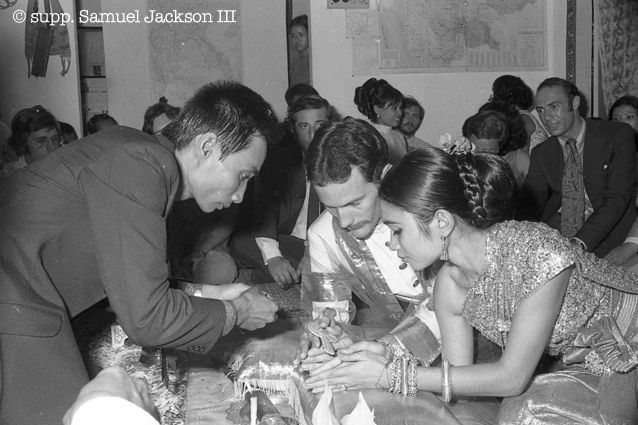


































































Samuel Jackson Archive
��Click image to view
Samuel Jackson III was living in Phnom Penh from 1971-75. During that time he rented a riverside apartment in the legendary Grand Hotel Manolis, became a monk, co-started a school, and got married - in that order and not simultaneously.
In 2019 he presented his collection of photos from the Lon Nol era to Bophana Center in Phnom Penh. Although these are personal photographs, they are also of considerable historical interest because of their coverage of that sparsely documented period.
Bophana Center is a treasury of such material and they welcome contributions.
With Sam's permission, here is a selection featuring some of the notable and not-so-notable personalities of the time which I hope will convey a taste of the atmosphere of 'barang' high life in the early seventies.
The photographers are identified where possible, and invited to stake their claim where not. Photos of Pchum Ben were taken by Eddie Van Hoeke, and many of the wedding photos by Peter Wong. The 1971 pictures were taken by Sam himself.
Samdech Preah Mahā Somethea Dhipati Huot Tat (1893 – 1975) was the fifth Supreme Patriarch of the Maha Nikaya order of Cambodia.
Born in Oudong, he joined the monkhood when he was 13. In 1969, he succeeded Chuon Nath as the new Supreme Patriarch of the Maha Nikaya order upon the latter's death.
On 17 April 1975, immediately after the Khmer Rouge marched into Phnom Penh, Huot Tat and all Buddhist monks were ordered to leave the city. The next day, he was taken to Oudong, where he was humiliated and beaten. He was then executed at the Prang pagoda. His statue was later thrown into the Mekong River.
The Venerable Tor An, the monk in charge of the 'kot' (lodging house) where Sam stayed in Wat Ounalom, also died during the Khmer Rouge regime. The circumstances are unknown.
The Venerable Yos Huot survived, and is an influential intellectual who speaks out against corruption. He was the head of Ponleu Khmer, a Cambodian citizens' coalition for the constitution and, until recently, resident at Wat Langka in Phnom Penh. He is currently living in exile at the Cambodian Wat outside Paris.
The Venerable Ung Mean resided at the Cambodian Wat outside Washington DC until he died about 15 years ago.
Douc Rasy went on his first demonstration in 1942 at the age of 17 to demand the release of the dissident monk, the Venerable Hem Cheav. He lived and studied in Paris from 1947-1957 at the same time as Khieu Samphan and other Cambodians who would later become Khmer Rouge. On his return to Cambodia, he became a Deputy in Sihanouk's Sangkum in 1962. In the Lon Nol regime he helped to revive the Democratic Party in 1972 and, becoming a slight 'embarrassment' to the government, accepted a posting as Ambassador to the UK in London after negotiating the release of Bouy Sreng, editor of the magazine 'Sangkruos Khmer'. When the Khmer Rouge took over, he went to France, where he remained for most of his later life. Douc Rasy passed away on 8th March 2020 at the age of 95.
(*Thanks to Mr. Ung Bunleng for much of this information)
Tim Carney, who was Second Secretary at the US Mission from 1972-75, and is fluent in Khmer, Thai and French, later became Director of Information and Education with UNTAC from 1992-93. He then served as US Ambassador to Sudan (1995-97) and Haiti (1998-99). He now lives in Washington DC.